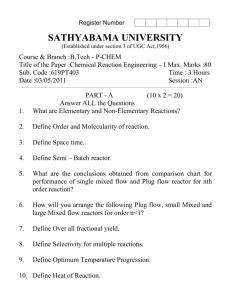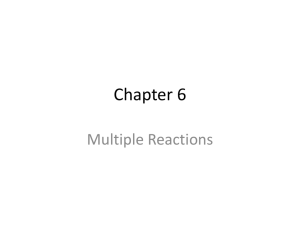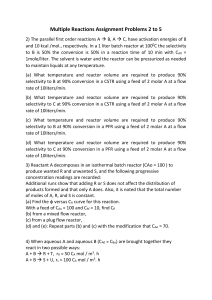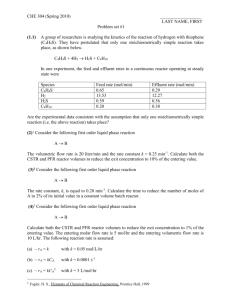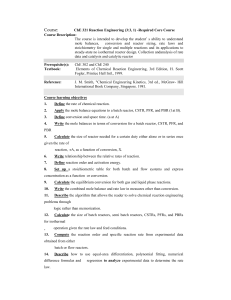Very often undesirable reactions and desired reactions occur
advertisement
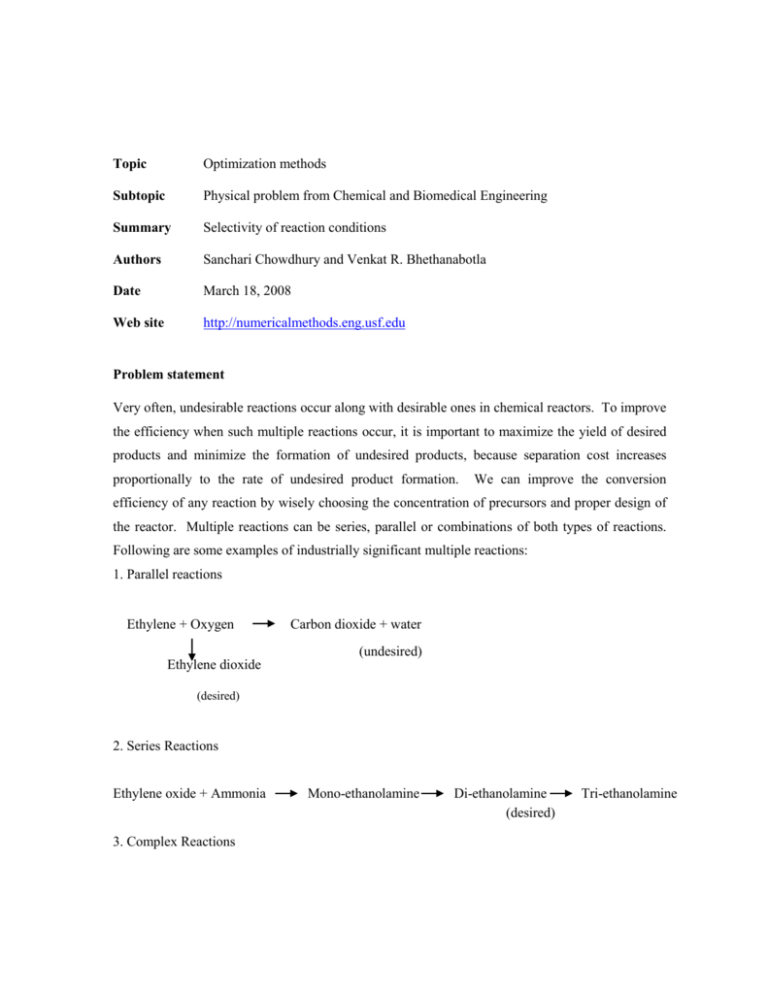
Topic Optimization methods Subtopic Physical problem from Chemical and Biomedical Engineering Summary Selectivity of reaction conditions Authors Sanchari Chowdhury and Venkat R. Bhethanabotla Date March 18, 2008 Web site http://numericalmethods.eng.usf.edu Problem statement Very often, undesirable reactions occur along with desirable ones in chemical reactors. To improve the efficiency when such multiple reactions occur, it is important to maximize the yield of desired products and minimize the formation of undesired products, because separation cost increases proportionally to the rate of undesired product formation. We can improve the conversion efficiency of any reaction by wisely choosing the concentration of precursors and proper design of the reactor. Multiple reactions can be series, parallel or combinations of both types of reactions. Following are some examples of industrially significant multiple reactions: 1. Parallel reactions Ethylene + Oxygen Carbon dioxide + water (undesired) Ethylene dioxide (desired) 2. Series Reactions Ethylene oxide + Ammonia 3. Complex Reactions Mono-ethanolamine Di-ethanolamine (desired) Tri-ethanolamine Reaction kinetics for the production of maleic anhydride by the air oxidation of benzene using a vanadium pentoxide catalyst [1] O2 Maleic anhydride (desired) O2 O2 Benzene Carbon dioxide + water Selectivity in multiple reactions indicates how one product is favored over another. It is defined as follows: selectivity rate of formation of desired product rate of formation of undesired products By maximizing selectivity of the desired product, one can increase the efficiency of the process. Selectivity can be increased by choosing optimum concentration of reactants, and by optimum configuration of the reactor. With this background two problems for optimization are suggested below: 1. Following are parallel reactions with appropriate rate equations. This reaction scheme was given by Trambouze et al. [2] rX .025 mol/(liter.sec) A X (undesired) Rate of formation of X: A Y (desired) Rate of formation of Y: ry 0.2C A mol/(liter.sec) A Z (undesired) Rate of formation of Z rZ 0.4C A mol/(liter.sec) 2 CA is the concentration of A. Selectivity of this reaction in terms of desired product is S Y / XZ ry rx rz Determine the concentration of reactant A at which the reactor should be operated to achieve maximum conversion to the desired product Y. (2) Electrooxidation of methanol on planar platinum in alkaline electrolytes is carried out in packed bed electrochemical reactors [3]. Suggest the optimum volume (V) of catalyst in the reactor for maximizing the yield of desired product. -2e -4e CH3OH HCOO- CO32(desired) This equation can be represented as: A B C (desired) Rate of formation of B: rB v0 dCB k1 C A k2CB d Rate of reaction for A: rA v0 dC A k1C A d Where is the space-time, which can be related to volume (V) of catalyst using the following equation V / v0 k1 = 0.33 hr-1 When V=0 k2= 0.15 hr-1 CA0= 0.04 mol/liter The volumetric flow rate (v0) of the reactants in the reactor is 7200 liters/hr. References 1. Westerink EJ, Westerterp KR. Safe design of cooled tubular reactors for exothermic multiple reactions: multiple reaction networks Chem Eng. Sci. 1988;43,1051 2. Trambouze PJ, Piret EL. Continuous Stirred tank Reactors: Design for maximum conversions of raw material to desired product. Homogeneous reactions. AIChE J. 1959;5, 384 3. George PS. Criteria for selective path promotion in electrochemical reaction sequences. AIChE Journal 1979;25, 781
